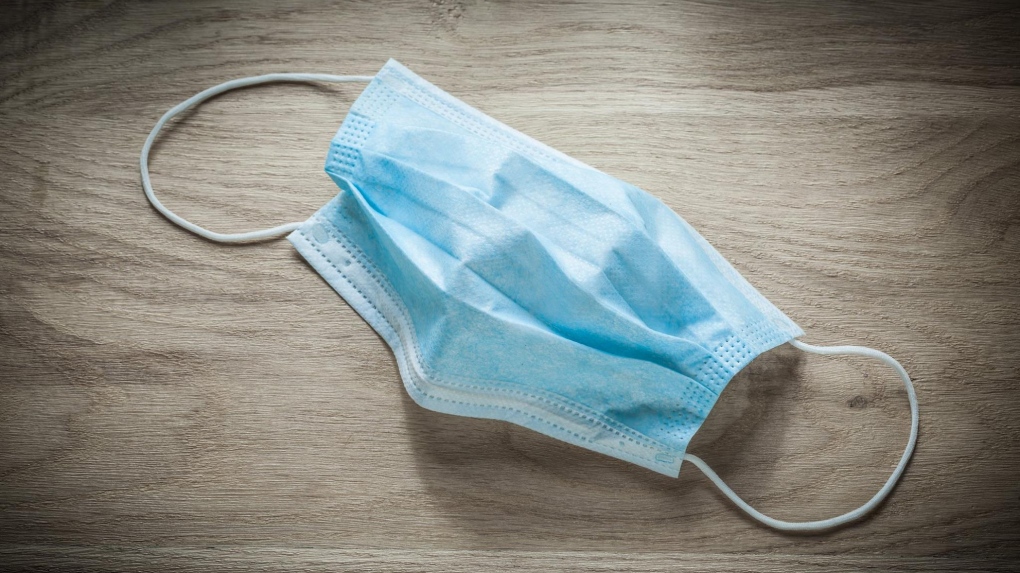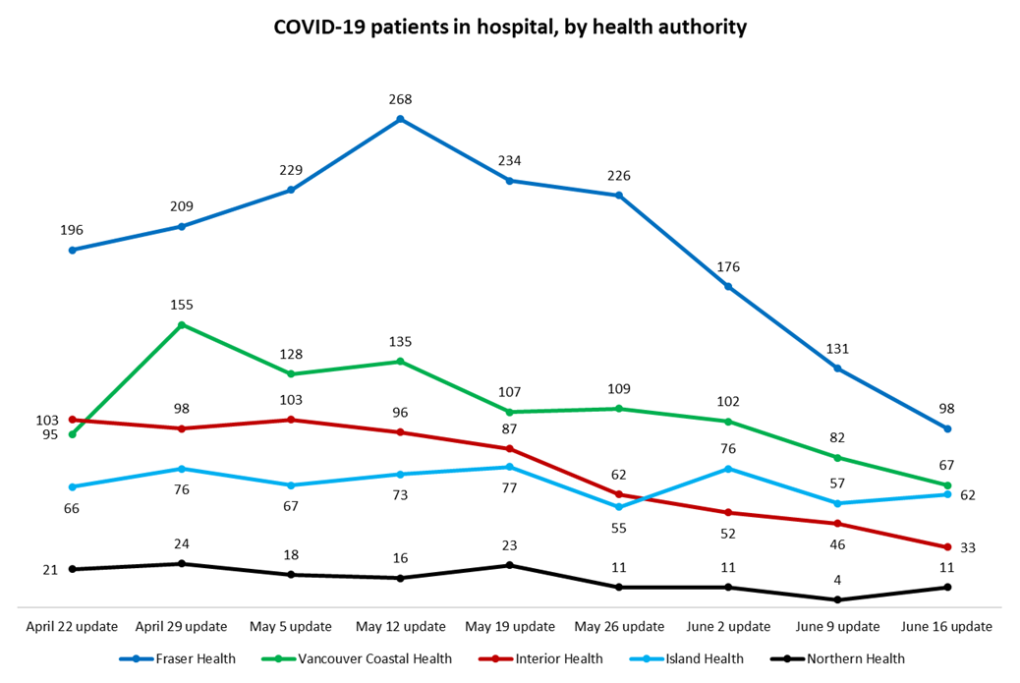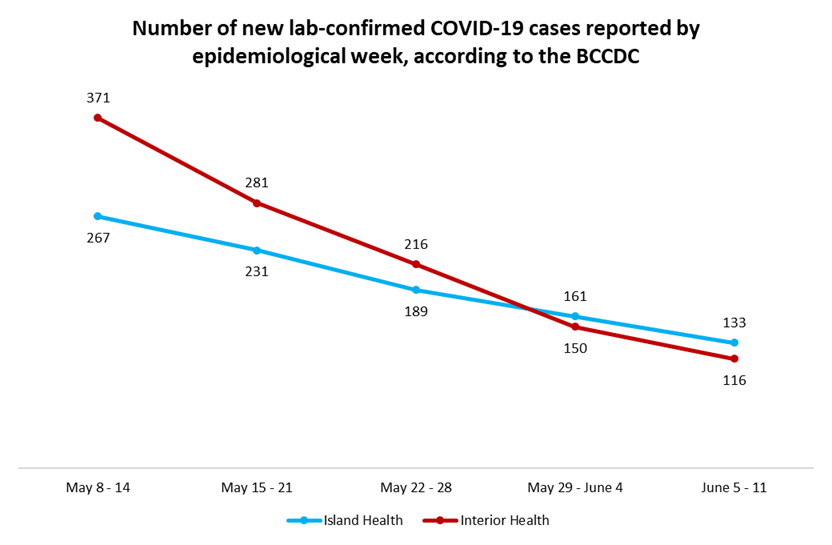Island Health sees COVID-19 hospitalizations stagnate as provincewide total declines
 A disposable face mask is seen in this file photo from Island Health. (Island Health/Facebook)
A disposable face mask is seen in this file photo from Island Health. (Island Health/Facebook)
The overall number of people with COVID-19 in B.C. hospitals continued to decline this week, but on Vancouver Island and in the province's north, the trend was reversed.
Island Health saw five more people in hospital with COVID-19 on Thursday (62) than it had at the same time the previous week (57), and Northern Health's hospital census grew by seven (from 4 to 11).
 This graph shows the number of test-positive COVID-19 patients in B.C. hospitals by health authority on Thursdays from April 22 to June 16. While most health authorities have seen a decline in that time, Island Health's numbers have remained fairly consistent.
This graph shows the number of test-positive COVID-19 patients in B.C. hospitals by health authority on Thursdays from April 22 to June 16. While most health authorities have seen a decline in that time, Island Health's numbers have remained fairly consistent.
The total number of coronavirus patients in B.C. hospitals has been declining for weeks. On Thursday, it dropped to 276, the second-lowest it's been on a Thursday since the start of the year.
Over the last three weeks, much of the decline has been driven by the province's two largest health authorities, Fraser Health and Vancouver Coastal Health.
Fraser Health saw its test-positive patient total drop below 100 to 98 on Thursday, and Vancouver Coastal Health's total dropped to 67, just five more than Island Health despite one-and-a-half times the population.
Interior Health – which has a population roughly equivalent to Island Health's – has also seen a significant decline in hospitalizations in recent weeks. The Interior's hospital census dropped from 46 on June 9 to 33 on Thursday, continuing six straight weeks of declines.
Since May 5, Interior Health has seen its hospitalizations drop by 68 per cent (from 103 to 33), while Island Health's total has declined by just 7 per cent in the same time period (from 67 to 62).
All of the hospitalization figures released by the B.C. Centre for Disease Control reflect "hospital census" totals, meaning they include people who test positive for COVID-19 incidentally while hospitalized for something else, as well as those who have serious cases of COVID requiring hospitalization.
Hospitalizations are generally a lagging indicator of coronavirus transmission, which means they start to increase or decrease a week or more after infection totals.
Given B.C.'s limited testing for COVID-19, it's impossible to know exactly how many people in each health authority have the disease at any given time.
Looking at the cases B.C. does track – namely those confirmed through lab testing, which is offered only to people with symptoms in a handful of specific settings where a positive result will affect treatment plans – it's clear that cases have been declining everywhere in recent weeks.
Notably, however, they've been declining faster in Interior Health than they have in Island Health, just like hospitalizations.
 This graph shows the number of new cases of COVID-19 reported by the B.C. Centre for Disease Control in Island Health and Interior Health each week since May 8, 2022. (CTV)
This graph shows the number of new cases of COVID-19 reported by the B.C. Centre for Disease Control in Island Health and Interior Health each week since May 8, 2022. (CTV)
Of course, case rates are not the only thing that affects hospitalization totals. Factors including age, vaccination status, severity of illness and length of hospital stay also play a role in determining the numbers the BCCDC releases each week.
For at least the last several weeks, however, Island Health – and to a lesser extent Northern Health – have been outliers relative to the overall provincial trend.
CTVNews.ca Top Stories

Scurvy resurgence highlights issues of food insecurity in Canada's rural and remote areas
A disease often thought to only affect 18th century sailors is reemerging in Canada.
Lotto Max jackpot hits $80M for second time ever
The Lotto Max jackpot has climbed to $80 million for just the second time in Canadian lottery history.
Canada 'already past due' on NATO defence spending target: U.S. House intelligence committee chair Mike Turner
The chair of the United States House intelligence committee says Canada needs to accelerate its defence spending targets, especially with its military in 'desperate' need of investment.
Anti-NATO protest in Montreal continues as politicians denounce Friday's violence
Federal cabinet ministers condemned an anti-NATO protest in Montreal that turned violent on Friday, saying "hatred and antisemitism" were on display, but protesters deny the claim, saying they demonstrated against the "complicity" of NATO member countries in a war that has killed thousands of Palestinians.
Bluesky takes bite out of X, as global users flee social media giant: analyst
A Canadian technology analyst says it appears Bluesky has legitimate growth momentum in the U.S. and elsewhere, and could be a significant threat to X.
Max Verstappen wins fourth straight World Championship as George Russell takes victory in Las Vegas
Max Verstappen claimed the Formula One World Drivers’ Championship at Las Vegas Grand Prix that saw George Russell take victory for Mercedes.
Nova Scotia Tories appear safe with close battle for second between Liberals and NDP
With two days left before Nova Scotians elect their next government, polls suggest Progressive Conservative Leader Tim Houston's decision to call an early vote will pay off and the real battle will be between the Liberals and NDP for second place.
Police thought this gnome looked out of place. Then they tested it for drugs
During a recent narcotics investigation, Dutch police said they found a garden gnome made of approximately two kilograms of MDMA.
These vascular risks are strongly associated with severe stroke, researchers say
Many risk factors can lead to a stroke, but the magnitude of risk from some of these conditions or behaviours may have a stronger association with severe stroke compared with mild stroke, according to a new study.


































